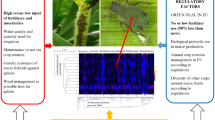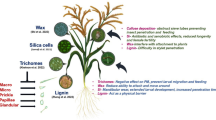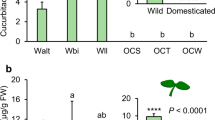Abstract
Priming is an induced defence mechanism in which plants that have been exposed to elicitors, such as herbivore-induced plant volatiles (HIPVs), go into an alert state with faster and stronger responses against a future biotic challenge. This study evaluated whether HIPVs emitted by maize genotypes after herbivory by fall armyworm (Spodoptera frugiperda) larvae could prime neighbouring maize plants for an enhanced indirect defence response, and if priming was consistent across different genotypes. Two genotypes were selected based on their differences in HIPV emission: Sintético Spodoptera (SS), a relatively high emitter of HIPVs, and L3, a relatively low emitter of HIPVs. SS plants that were previously exposed to SS HIPVs initiated earlier and enhanced volatile production upon larval challenge, compared to SS plants that were previously exposed to SS undamaged plant volatiles. In addition, SS plants exposed to SS HIPVs and then to larval challenge attracted an egg parasitoid, Telenomus remus, at an earlier stage than SS plants that were only subjected to larval challenge, indicating a priming effect. There was no evidence of a priming response by L3 plants that were previously exposed to L3 or SS HIPVs. When comparing the gene expression of HIPV-exposed and undamaged plant volatile (UDV)-exposed plants, jasmonate-induced protein GRMZM2G05154 and UDP-glucosyltransferase bx8 genes related to the biosynthesis of DIBOA-Glu were upregulated. These data indicate that priming by HIPVs enhances indirect defence in maize plants as reported by other studies, and provide new information showing that the priming effect can be genotype-specific.







Similar content being viewed by others
Data availability
All data supporting the findings of this study are available within the paper and within its supplementary materials published online.
References
Alelo Bank germplasm identification data (2020) http://alelobag.cenargen.embrapa.br/AleloConsultas/Home/index.do?lang=english
Anders S, Pyl PT, Huber W (2014) HTSeq—a Python framework to work with high-throughput sequencing data. Bioinformatics 31:166–169
Bernardi D, Salmeron E, Horikoshi RJ, Bernardi O, Dourado PM, Carvalho RA et al (2015) Cross-resistance between Cry1 proteins in fall armyworm (Spodoptera frugiperda) may affect the durability of current pyramided Bt maize hydrids in Brazil. PLoS One 10:e0140130. https://doi.org/10.1371/journal.pone.0140130
Blassioli-Moraes MC, Borges M, Michereff MFF, Magalhães DM, Laumann RA (2016) Semiochemicals from plants and insects on the foraging behavior of Platygastridae egg parasitoids. Pesq Agropec Bras 51:454–464
Blassioli-Moraes MC, Michereff MFF, Magalhães DM, Morais SM, Hassemer MJ, Laumann RA, Meneghin AM, Birket MA, Withall DM, Medeiros JM, Correa CMC, Borges M (2019) Influence of constitutive and induced volatiles from mature green coffee berries on the foraging behaviour of female coffee berry borers, Hypothenemus hampei (Ferrari) (Coleoptera: Curculionidae: Scolytinae). Arthropod-Plant Interact 13:349–358. https://doi.org/10.1007/s11829-018-9631-
Bolger AM, Lohse M, Usadel B (2014) Trimmomatic: a flexible trimmer for Illumina sequence data. Bioinformatics 30:2114–2120
Bruin J, Dicke M (2001) Chemical information transfer between wounded and unwounded plants: backing up the future. Biochem Syst Ecol 29:1103–1113
Bruin J, Dicke M, Sabelis M (1992) Plants are better protected against spider-mites after exposure to volatiles from infested conspecifics. Experientia 48:525–529
Bruce TJA, Pickett JA (2007) Plant defence signalling induced by biotic attacks. Curr Opin Plant Biol 10:387–392
Bruce TJA, Pickett JA (2011) Perception of plant volatile blends by herbivorous insects—finding the right mix. Phytochemistry 72:1605–1611
Bruce TJA, Matthes M, Chamberlain K, Woodcock CM, Mohib A, Webster B, Smart LE, Birkett MA, Pickett JA, Napier JA (2008) Multitrophic interactions involving Arabadopsis thaliana investigated by means of cis-jasmone defence activation. Proc Natl Acad Sci USA 105:4553–4558
Chen C, Chen H, Huang S, Jiang T, Wang C, Tao Z, He C, Tang Q, Li P (2021) Volatile DMNT directly protects plants against Plutella xylostella by disrupting the peritrophic matrix barrier in insect midgut. e-life. https://elifesciences.org/articles/63938
Coppola M, Cascone P, Madonna V, Di Lelio I, Esposito F, Avitabile C, Romanelli A, Guerrieri E, Vitiello A, Pennachio F, Rao R, Corrado G (2017) Plant-to-plant communication triggered by systemin primes anti-herbivore resistance in tomato. Sci Rep 7:15522. https://doi.org/10.1038/s41598-017-15481-8
Costa LP, Sena MR, Guimarães PEO de, Viana PA, Pacheco CAP (2006) Avaliação de linhagens de milho para resistência à lagarta-do-cartucho, Spodoptera frugiperda (J. E. Smith). In: 26° Congresso Nacional de Milho e Sorgo, Belo Horizonte, 2006. Available in: https://www.embrapa.br/busca-de-publi cacoes/-/publicacao/490124/avaliacao-de-linhagens-de-milho -para-resistencia-a-lagarta-do-cartucho-spodoptera-frugiperda -j-e-smith. Accessed 26 Feb 2018
Cruz I (1995) A lagarta-do-cartucho na cultura do milho. Circular Técnica/Embrapa Milho e Sorgo 21:1–45
Cruz I, Figueiredo MLC, Silva RB (2010) Monitoramento de adultos de Spodoptera frugiperda (J. E. Smith) (Lepidoptera: Noctuidae) e Diatraea saccharalis (Fabricius) (Lepidoptera: Pyralidae) em algumas regiões produtoras de milho no Brasil. Documentos/Embrapa Milho e Sorgo 93:1–42
Dicke M, Bruin J (2001) Chemical information transfer between plants: back to the future. Biochem Syst Ecol 29:981–994
Dicke M, Sabelis MW, Takabayashi J, Bruin J, Posthumus MA (1990) Plant strategies of manipulating predator–prey interactions through allelochemicals: prospects for application in pest control. J Chem Ecol 16:3091–3118
Engelberth J, Alborn HT, Schmelz EA, Tumlinson JH (2004) Airborne signals prime plants against insect herbivore attack. Proc Natl Acad Sci USA 101:1781–1785
Engelberth J, Seidi-Adams I, Schultz J, Tumlinson JH (2007) Insect elicitors and exposure to green leafy volatiles differentially upregulate major octadecanoics and transcripts of 12-oxo phytodienoic acid reductases in Zea mays. Mol Plant-Microbe Interact 20:707–716
Erb M, Veyrat N, Robert CAM, Xu H, Frey M, Ton J, Turlings TCJ (2015) Indole is an essential herbivore-induced volatile priming signal in maize. Nat Commun 6:1–10
Fancelli M, Borges M, Laumann RA, Pickett JA, Birkett MA, Blassioli-Moraes MC (2018) Attractiveness of host plant volatile extracts to the Asian Citrus Psyllid, Diaphorina citri, is reduced by terpenoids from the non-host cashew. J Chem Ecol 44:397–405
Faria JR, Andow DA, Horikoshi RJ, Sorgatto RJ, Fresia P, Santos AC, Omoto C (2014) Field-evolved resistance to Cry1F maize by Spodoptera frugiperda (Lepidoptera: Noctuidae) in Brazil. Crop Prot 64:150–158
Figueiredo MLC, Cruz I, Della Lucia TMC (1999) Controle integrado de Spodoptera frugiperda (Smith & Abbott) utilizando-se o parasitoide Telenomus remus Nixon. Pesq Agropecu Bras 34:1975–1982
Figueiredo MLC, Della Lucia TMC, Cruz I (2002) Effect of Telenomus remus Nixon (Hymenoptera: Scelionidae) on control of Spodoptera frugiperda (J. E. Smith) (Lepidoptera: Noctuidae) egg masses upon release in a maize field. Rev Bras Milho e Sorgo 1:12–19
Frost CJ, Mescher MC, Dervinis C, Davis JM, Carlson JE, De Moraes CM (2008) Priming defense genes and metabolites in hybrid poplar by the green leaf volatiles cis-3-hexenyl acetate. New Phytol 180:722–734
Hare JD (2011) Ecological role of volatiles produced by plants in response to damage by herbivorous insects. Annu Rev Entomol 56:161–180
Heil M, Ton J (2008) Long-distance signalling in plant defence. Trends Plant Sci 13:264–272
Hilker M, Schwachtje J, Baier M, Bäurle J, Geselhardt J, Hincha DK, Kunze R, Mueller-Roeber B, Rillig MC, Rolff J, Romeis T, Schmülling T, Steppuhn A, van Dongen J, Wjitcomn SJ, Wurst E, Kopka J (2016) Priming and memory of stress response in organisms lacking a nervous system. Biol Rev 9:1118–1133
Hu L, Ye M, Erb M (2018) Integration of two herbivore-induced plant volatiles results in synergistic effects on plant defence resistance. Plant Cell Environ 42:959–971
**g T, Du W, Gao T, Wu Y, Zhang N, Zhao M, Jieyang J, Schwab W, Wan X, Song C (2020) Herbivore induced DMNT catalyzed by CYP82D47 plays an important role in the induction of JA-dependent herbivore resistance of neighboring tea plants. Plant Cell Environ. https://doi.org/10.1111/pce13861
Kim D, Pertea G, Trapnell C, Pimentel H, Kelly B, Salzberg S (2013) TopHat2: accurate alignment of transcriptomes in the presence of insertions, deletions and gene fusions. Genome Biol 14:R36. https://doi.org/10.1186/gb-2013-14-4-r36
Kessler A, Halitschke R, Diezel C, Baldwin IT (2006) Priming of plant defense responses in nature in nature by airborne signalling between Artemisa tridentate and Nicotiana attenuate. Oecologia 148:280–292
Leopold EJ (1990) Selective hydroboration of a 1,3,7-triene homogeraniol. Org Synth 64:164–171
Magalhães DM, Borges M, Laumann RA, Woodcock CM, Pickett JA, Birkett MA, Blassioli-Moraes MC (2016) Influence of two acyclic Homoterpenes (Tetranorterpenes) on the foraging behavior of Anthonomus grandis Boh. J Chem Ecol 42:305–313. https://doi.org/10.1007/s10886-016-0691-1
Magalhães DM, Borges M, Laumann RA, Woodcock CM, Withall DM, Pickett JA, Birkett MA, Blassioli-Moraes MC (2019) Identification of volatile compounds involved in host location by Anthonomus grandis (Coleoptera: Curculionidae). Front Ecol Evol 6:98. https://doi.org/10.3389/fevo.2018.00098
Moraes MCB, Sereno FTPS, Michereff MFF, Pareja M, Laumann RA, Birkett MA, Pickett JA, Borges M (2009) Attraction of the stink bug egg parasitoid, Telenomus podisi (Hymenoptera: Scelionidae) to defence signals from soybean, Glycine max (Fabaceae), activated by treatment with cis-jasmone. Entomol Exp Appl 131:178–188
Mauch-Mani B, Baccelli I, Luna E, Flors V (2017) Defense priming: an adaptive part of induced resistance. Annu Rev Plant Biol 68:485–512
Michereff MFF, Laumann RA, Borges M, Michereff-Filho M, Diniz IR, Farias NAL, Moraes MCB (2011) Volatiles mediating plant-herbivory-natural enemy interaction in resistant and susceptible soybean cultivars. J Chem Ecol 37:273–285
Michereff MFF, Borges M, Aquino MFS, Laumann RA, Mendes Gomes ACM, Blassioli-Moraes MC (2016) The influence of volatile semiochemicals from stink bug eggs and oviposition-damaged plants on the foraging behaviour of the egg parasitoid Telenomus podisi. Bull Entomol Res 1:1–9
Michereff MFF, Magalhães DM, Hassemer MJ, Laumann RA, Zhou J-J, Ribeiro PE de A, Viana PA, Guimarães PE de O, Schimmelpheng PHC, Borges M, Pickett JA, Birkett MA, Blassioli-Moraes MC (2019) Variability in herbivore-induced defence signalling across different maize genotypes impacts on natural enemy foraging behaviour. J Pest Sci 92:723–736
Mitchell A, Chang H-Y, Daugherty L, Fraser M, Hunter S, Lopez R, McAnulla C et al (2015) The InterPro protein families database: the classification resource after 15 years. Nucleic Acids Res 43:D213–D221
Moraes MCB, Pareja M, Laumann RA, Hoffmann-Campo CB, Borges M (2008) Response of the parasitoids Telenomus podisi to induced volatiles from soybean damaged by stink bug herbivory and oviposition. J Plant Interact 3:1742–1756
Mutyambai DM, Bruce TJA, van den Berg J, Midega CAO, Pickett JA, Khan ZR (2016) An indirect defence trait mediated through egg-induced maize volatiles from neighbouring plants. PLoS One 11(7):e0158744. https://doi.org/10.1371/journal.pone.0158744
NIST (2008) Software NIST/EPA/NIH Mass spectral library. https://chemdata.nist.gov/dokuwiki/doku.php?id=chemdata:downloads:start
Oluwafemi S, Dewhirst SY, Veyrat N, Powers S, Bruce TJA, Caulfield JC, Pickett JA, Birkett MA (2013) Priming of production in maize of volatile organic defence compounds by the natural plant activator cis-Jasmone. PLoS One 8:e62299
Peñaflor MFGV, Erb M, Miranda LA, Werneburg AG, Bento JMS (2011) Herbivore-induced plant volatiles can serve as host location cues for a generalist and a specialist egg parasitoid. J Chem Ecol 37:1304–2131
Pickett JA, Khan ZR (2016) Plant volatile-mediated signalling and its application in agriculture: successes and challenges. New Phytol 212:856–870
Pomari AF, Bueno AF, Bueno RCOF, Menezes AO Jr, Fonseca ACPF (2013) Releasing number of Telenomus remus (Nixon) (Hymenoptera: Platygastridae) against Spodoptera frugiperda Smith (Lepidoptera: Noctuidae) in corn, cotton and soybean. Cienc Rural 43:377–382
Prasanna BM (2014) Maize in the develo** world: trends, challenges, and opportunities. In: Proceeding International Maize Conference. http://pangan.litbang.pertanian.go.id/files/IMC-PDF/03-Prasanna.pdf/. Accessed in 24 April 2018
Prüfer K, Muetzel B, Do H-H, Weiss G, Khaitovich P, Rahm E, Pääbo S, Lachmann M, Enard W (2007) FUNC: a package for detecting significant associations between gene sets and ontological annotations. BMC Bioinform 41:1–10
Ramadam A, Muroi A, Arimura GI (2011) Herbivore-induced maize volatiles serve as priming cues for resistance against post-attack by the specialist armyworm Mythimna separate. J Plant Interact 6:155–158
R Core Team (2020) R: A language and environment for statistical computing. R Foundation for Statistical Computing, Vienna, Austria. http://www.R-project.org/
Risso D, Ngai J, Speed T, Dudoit S (2014) Normalization of RNA-seq data using factor analysis of control genes or samples. Nat Biotechnol 32:896–902
Robinson MD, McCarthy DJ, Smyth GK (2010) edgeR: a Bioconductor package for differential expression analysis of digital gene expression data. Bioinformatics 26:139–140
Schmidt FGV, Monnerat R, Borges M, Carvalho R (2001) Criação de insetos para avaliação de agentes entomopatogênicos e semioquímicos. Circular Técnica/Embrapa Recursos Genéticos e Biotecnologia 21:1–20
Schröder R, Hilker M (2008) The relevance of background odor in resource location by insects: a behavioral approach. Bioscience 58:308–316
Silveira LCP, Vendramim JD, Rossetto CJ (1997) Efeito de genótipos de milho no desenvolvimento de Spodoptera frugiperda (J.E. Smith). An Soc Entomol Bras 26:291–298
Tamiru A, Bruce TJA, Woodcock CM, Caulfield JC, Midega CAO, Ogol CKPO, Mayon P, Birkett MA, Pickett JA, Khan ZR (2011) Maize landraces recruit egg and larval parasitoids in response to egg deposition by a herbivore. Ecol Lett 14:1075–1083
Tasin M, Bäckman A-C, Coracini M, Casado D, Ioratti C, Witzgall P (2007) Synergism and redundancy in a plant volatile blend attracting grapevine moth females. Phytochemistry 68:203–209
Ton J, D’alessandro M, Jourdie V, Jakab G, Karlen D, Held M, Mauch-Mani B, Turlings TCJ (2007) Priming by airborne signals boosts direct and indirect resistance in maize. Plant J 49:16–26
Toscano LC, Calado Filho GC, Cardoso AM, Maruyama WI, Tomquelski GV (2012) Impact of insecticides on Spodoptera frugiperda (Lepidoptera, Noctuidae) and its natural enemies on off-season maize in Cassilândia and Chapadão do Sul, State of Mato Grosso do Sul, Brazil. Arq Inst Biol 79:223–231
van den Brink PJ, ter Braak CJF (1999) Principal response curves: analysis of time dependent multivariate responses of a biological community to stress. Environ Toxicol Chem 18:138–148
van Hulten M, Pelser M, van Loon LC, Pieterse CMJ, Ton J (2006) Costs and benefits of priming for defense in Arabidopsis. Proc Natl Acad Sci USA 103:5602–5607
Viana PA, Potenza MR (2000) Avaliação de antibiose e não-preferência em cultivares de milho selecionados com resistência à lagarta- do cartucho. Bragantia 59:27–33
Vries J, Evers JB, Poelman EH (2016) Dynamic plant–plant–herbivore interactions govern plant growth-defence integration. Trends Plant Sci 22:1–9
Woüters FC, Blanchette B, Gershenzon J, Vassão DG (2016) Plant defense and herbivore counter-defense: benzoxazinoids and insect herbivores. Phytochem Rev 15:1127–1151
Wu F, Guclu H (2013) Global Maize Trade and Food Security: implications from a Social Network Model. Risk Anal 33:2168–2178
Yamasaki K, Kigawa T, Inoue M, Tateno M, Yamasaki T, Yabuki T, Aoki M, Seki E, Matsuda T, Tomo Y, Hayami N, Terada T, Shirouzo M, Tanaka A, Seki M, Shinozaki K, Yokoyama S (2005) Solution structure of an Arabidopsis WRKY DNA binding domain. Plant Cell 17:944–956
Ye M, Glauser G, Lou Y, Erb M, Hu L (2019) Molecular dissection of early defense signalling underlying volatile-mediated defense regulation and herbivore resistance in rice. Plant Cell 31:687–698
Zhang PJ, Wei JN, Zhao C, Zhang YF, Li CY, Liu SS, Dicke M, Yu XP, Turlings TCJ (2019) Airborne host–plant manipulation by whiteflies via an inducible blend of plant volatiles. Proc Natl Acad Sci USA 116:7387–7396
Zhou S, Richter A, Jander G (2018) Beyond defense: multiple functions of benzoxazinoids in maize metabolism. Plant Cell Physiol 59:1528–1537
Acknowledgements
We thank Isabela Grisi, Sulian Gomes de Azevedo and Helio Moreira do Santos for hel** with laboratory rearing of the insects. Dr. Ivan Cruz for providing the egg parasitoid Telenomus remus to establish our colony. This work received financial support from the National Counsel of Technological and Scientific Development (CNPq), the Federal District Research Foundation (FAP-DF-CONFAP Grant 193000003/2015) and the Brazilian Corporation of Agricultural Research (EMBRAPA). The work at Rothamsted forms part of the Smart Crop Protection (SCP) strategic programme (BBS/OS/CP/000001) funded through Biotechnology and Biological Sciences Research Council’s Industrial Strategy Challenge Fund. This work was also supported by a BBSRC-Newton Fund Grant BB/M029204/1.
Author information
Authors and Affiliations
Contributions
MFFM, MCBM, MAB, JJZ, MB, RAL and PG conceived the ideas and designed methodology; MFFM, PHCS and MCBM collected the data; MFFM, MCBM, RCT, MMCC and PG analysed the data; MFFM, MB, PG and MCBM led writing of the manuscript. All authors contributed critically to the drafts and gave final approval for publication.
Corresponding author
Ethics declarations
Conflict of interest
The authors declare that they have no conflict of interest.
Additional information
Handling Editor: Hongbo Jiang.
Publisher's Note
Springer Nature remains neutral with regard to jurisdictional claims in published maps and institutional affiliations.
Supplementary Information
Below is the link to the electronic supplementary material.
Rights and permissions
About this article
Cite this article
Michereff, M.F.F., Grynberg, P., Togawa, R.C. et al. Priming of indirect defence responses in maize is shown to be genotype-specific. Arthropod-Plant Interactions 15, 313–328 (2021). https://doi.org/10.1007/s11829-021-09826-4
Received:
Accepted:
Published:
Issue Date:
DOI: https://doi.org/10.1007/s11829-021-09826-4




